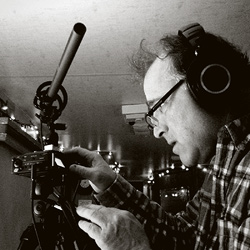The Dome
Experimental filmmaker and all around creative genius Bart Santello is the subject of the gripping documentary The Dome by Adam Ray. Bart was kind enough to discuss the creation of an organic space made solely from a natural earthen composition, the undaunted human will to form its structure, and his approach to filmmaking.

AIFF - The desert climate can be unforgiving at certain times of the year. One of the elements of the film that struck me was endurance. How did you keep from exhaustion and stay focused on both filmmaking and constructing the dome?
Bart - And there are other interests I pursue also. My way to persist in anything is to remove the element of 'time'. Just as I have been working the structure from which the dome was built upon for over 10-years now; I just completed a film that took over 10-years to make. But that's ok. That period was needed to allow the original idea of a particular project to fully express itself.
AIFF - One very interesting idea you mentioned was not planning the dome's construction. Is that your film making style also, let the structure form itself and allow for enhanced creativity?
Bart - Originally when I started this earthen structure, I was thinking low-profile for its visual aesthetic in the desert. The west side of the building is buried in the hillside, so I thought that at certain vantage points on the landscape, the structure may not even be visible. Since the building process continued for years, there was a period where I was reading books on Egyptian arches and domes by architect Hassan Fathy. Then after a trip to Italy, I could not let the opportunity pass, especially since I had already constructed a 12-foot diameter circular room.
In regards to my filmmaking style being similar to the experience above – absolutely. All my films originate with an idea, then I identify the things I'm drawn to that support the idea and film those inspired moments. I call these 'elements'. Then like assembling a jigsaw puzzle, the elements when combined become building-blocks that form the story. The film's consciousness begins to integrate and evolve. New insights emerge as a result and thus the film's production essentially a subconscious process.
This approach is opposite of typical films, where the writer, director and producer assemble the complete story first, then film a pre-formulated story.
AIFF - Is the science related to the composition of the “cob” (nature's fiberglass) used to build the structure, related to the science and creativity of making a film?
Bart - Only if you're speaking metaphorically about physical strength in relation to a film's 'strength'; that being, the idea behind the film is creatively expressed in the film.
AIFF - The texture of The Dome is rich and layered, how does that inform this film's style, and some of your other work such as Outskirts of Infinity.
Bart - Adam Ray as the director provided the structure and style of The Dome. As a collaborating filmmaker and also the person in the story, my role was to provide its 'consciousness', by reflecting on the aspects of the story that I wanted to convey within the framework that Adam provided. My contribution thus can be considered a layer or integrated elements in the story.
My 2006 film Outskirts of Infinity (https://vimeo.com/112452576) was my own production and is a deeply layered film that I'm still learning about with each viewing.
AIFF - When you visited the site at Chaco Canyon and found inspiration for building, what were some elements that influenced you visually and spiritually?
Bart - I prefer to use the word 'inspired' rather than 'influenced' when referencing things that attract my attention creatively. With respect to my “cob” structure I wanted to create something unique and original. The same is true with my films. In my opinion, if you copy a theme or style you will be compared to that original and thus fall short.
The Anasazi buildings at Chaco in New Mexico demonstrated a commitment of creating something over the long-term; provided insight into how 'mass' – thick walls, are needed to keep varying desert temperatures mitigated; and the efficient use of local materials (rock, clay and wood for beams).
The most spiritual part of Chaco for me was the circular 'Kiva' rooms. A circular room is shunned in today's buildings, mostly due to the complexity of construction (especially when building with wood), but also the difficulty of placing furnishings. However, “cob” makes building a circular room seem natural and fewer furnishings are required because the room itself is the focus – the interior design statement.
AIFF - Is Arivaca a model for the world to follow? Is it possible for a city to incorporate the same ideals your community shares?
Bart - I think each location from an individual property to a major city has to develop and customize its own sustainable living plans and solutions. Arivaca is a unique location and community and its remote location provides the opportunity for experimentation. The community is certainly behind the environment, alternative energy and sustainable building.
But this is rare and it's getting harder for people to build and be sustainable. This could be a long topic, but in short, governments and corporations are closing-in on all the frontiers around the world. Meaning 'dependence', not independence is the political, economic and corporate ideal. Thus laws and regulations make it difficult for people to free themselves from 'the system'.
THE DOME received the Best of Arizona Award.